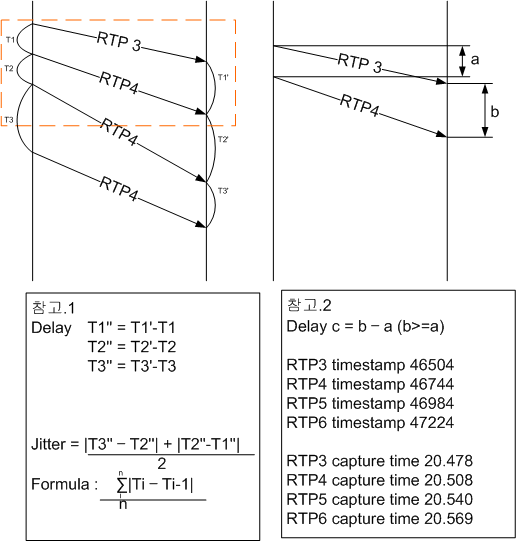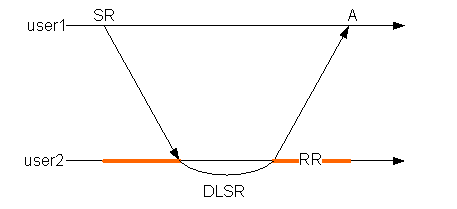* 이 문서에 대한 권한은 저자에게 있습니다.
퍼 가실때는 출처를 표시하여 주시고 메일로 연락을 주십시오. dif001@hamail.net
1. Jitter
Jitter는 네트웍 구간에서 Packet의 전송 지연 편차( delay variation) 이다.
참고.2에 나타난 수치들을 기준으로 값을 낸다.
RTP3-RTP4 delay
Local delay(codec delay) : 46744(5843) - 46504(5813) = 240 (codec delay:30ms)
값 240은 30msec으로 환산할 수 있다.
Local delay는 codec처리를 하는 시간으로서 codec의 종류에 따라 다른 일정한 시간을 가진다. 기본적으로 160(20ms) 와 240(30ms) 두가지 값을 가지게 된다.
Capture delay : 20.508 – 20.478 = 0.030 (30ms)
Packet을 수집하고 packet간의 딜레이를 측정한 것이다.
이 값은 msec까지만 측정한 것으로 실측에서는 usec에서의 오차가 있는 것으로 나타났다.
이상의 값으로 측정하였을 때
Network delay
Tn'' = T1'-T1
이상의 식으로 값을 내었을 때 아래와 같다.
RTP3-RTP4 delay
30ms(capture delay) – 30ms(local delay) = 0
RTP4-RTP5 delay
46984 – 46744 = 240 (30ms)
20.540 – 20.508 = 0.032 (32ms)
32ms – 30ms = 2ms
RTP5-RTP6 delay
47224 – 46984 = 240 (30ms)
20.569 – 20.540 = 0.029 (29ms)
29ms – 30ms = -1
Jitter = (RTP4-RTP5) - (RTP3-RTP4)
= |2 – 0| = 2
= (RTP5-RTP6) - (RTP4-RTP5)
= |2 + 1| = 3
= (2+3)/2
= 2.5ms
이상의 네트워크상의 Packet 전송 지연 편차를 구하는 방법이다.
2. End-To-End delay
End-To-End delay는 유저간의 전송시간을 측정하는 것이다.
그림에서 나타난 굵은색 부분이 총 one round trip 이다.
프로젝트에서 필요한 부분은 half round trip으로서 이값은 one round trip 값을 2로 나눈 값이다.
구하는 방법은 아래와 같다.
최초 RTCP 전송이 user1에서 user2로 전송될 때의 패킷 (Sender Report)
NTP reference timestamp
NTP second : 00 05 05 77
NTP fraction : f3 00 00 00
이 값은 user1측에서 데이터를 전송할 때의 시간이다.
이 값을 받은 user2는 일정시간(실측시간 5sec) 이 지난후에 RR(Receiver Report)메시지를 전송한다.
LSR (Last Send Report timestamp) : 05 77 f3 00
DLSR (delay since last SR) : 00 03 93 00
LSR은 SR메시지 상의 NTP timestamp의 일정부분을 추출한 값이다.
이 값은 timeval(msec, usec)으로 이루어진 값으로써 이값에서
msec부분의 하위 2byte 와 usec부분의 상위 2바이트를 추출하여 Round-trip값을 구하기 위한 지표값으로 사용한다.
DLSR은 SR메시지를 전달받고 RR메시지를 전송하기까지의 Local Processing Delay를 나타낸다 이 값은 timeval(msec, usec)형태로 이루어 져 있다.
위의 기본지식을 바탕으로 실측데이터를 가지고 End-To-End delay를 측정한다.
1. user1-SR (NTP timestamp)
NTP second : 00 05 05 77
NTP fraction : f3 00 00 00
2. agent-SR 수집 시간(Agent)
20.224(sec)
3. user2-RR-LSR,DLSR
LSR : 05 77 f3 00
DLSR : 00 03 93 00
4. Agent-RR수집시간
23.793(sec)
5. End-To-End delay
23.793-20.224-3.376 (반올림) = 0.193 (one round trip)
0.193/2 = 0.096 == 96ms
 글 검색 결과 - Network (총 5개)
글 검색 결과 - Network (총 5개)














